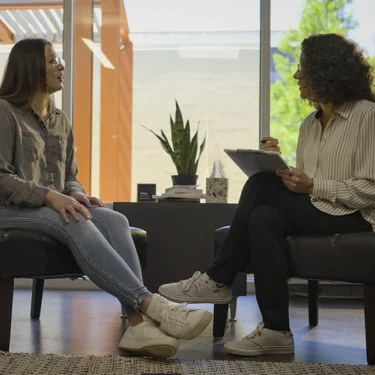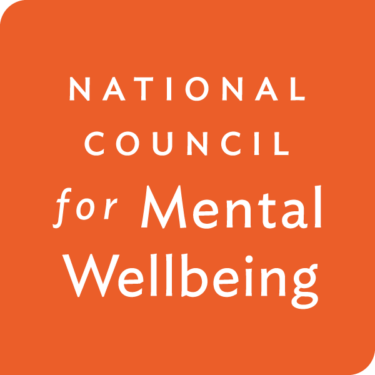The teenager who walked into Peoples Community Health Clinic, Inc., this summer admitted she used alcohol.
But she didn’t believe her drinking was a problem.
“For a lot of kids, they are not willing to admit that anything they’re using is a problem,” said Alexis Holmes LMSW, SUD, a counselor at Peoples.
But Holmes helped the young client connect the dots and had her speak with a mental health counselor on staff at the Federally Qualified Health Center (FQHC) based in Waterloo, Iowa.
“We set her up with a mental health counselor to work with her to develop coping skills for depression,” Holmes said. “I think we likely would not have had the conversation if I hadn’t talked to her about her alcohol use. She was willing to say, ‘I’m drinking.’ She wasn’t willing to say, ‘I’m depressed.’ A mental health counselor is going to address both of those things, especially because she is so young. She’s going to tell her ‘drinking is an issue because your brain is still developing’.”
It was a positive screening with a positive outcome, and it might not have happened a year ago because Peoples wasn’t treating youths for substance use or mental health challenges.
But in January, Peoples implemented Youth Screening, Brief Intervention, and Referral to Treatment (YSBIRT), an integrated and comprehensive, evidence-based, early intervention program. Peoples joined an increasing number of providers participating in the National Council’s Learning Collaborative to assist in implementing YSBIRT in primary care settings to identify, reduce and prevent alcohol and drug use, misuse and dependence among adolescents ages 12 to 18.
Peoples has screened 146 teenagers so far this year using YSBIRT. Thirteen teenagers have screened positive, and Peoples has been able to help those clients get the treatment and services they need.
YSBIRT screenings give providers confidence that adolescents are providing accurate information and communicating honestly, said Sara Kastli, BSN, RN, director of behavioral health at Peoples.
Implementing YSBIRT at Peoples required modest changes in their screening process. First, providers decided to ask youth clients to provide written responses to questions about substance use and mental health challenges, rather than asking them to provide verbal responses.
When it’s time to discuss the written responses with a client, physicians take the lead in the consultation. Peoples took that responsibility away from its nursing staff. They also removed parents from the equation. Both steps give physicians the confidence that youths will engage in an honest, open dialogue about their substance use and mental health challenges.
It also helped that Peoples had physicians on staff ready and willing to participate in screenings by asking difficult questions.
“The hardest part is asking youth about substance use. Those aren’t easy conversations,” Kastli said, “But this program provides a great opportunity to get in front of adolescents and prevent substance use and provide resources.”
Like Peoples, Community Health Centers of Southeastern Iowa, Inc., has introduced private time between providers and clients – without parents – and discovered that most parents understood that the discussions were more likely to give adolescents the freedom and comfort to communicate honestly.
“Among parents, I think 80% are completely fine with that,” said Rhea Hartley, DO, chief medical officer, Community Health Centers of Southeastern Iowa, in West Burlington, Iowa.
Community Health Centers introduced YSBIRT in July to fill a gap in service and so far they’ve screened about 100 adolescents.
“It was definitely something we needed to do – to counsel patients about the dangers of street drugs. We also saw it as an opportunity to counsel adolescents about healthy lifestyles,” Dr. Hartley said.
Neither Peoples nor Community Health Centers struggled to implement YSBIRT, though they needed to make some changes.
In addition to making adjustments in the screening process for youth clients, Peoples made other internal and external changes, like record keeping, but the clinic’s implementation of YSBIRT didn’t include insurmountable hurdles, Kastli said.
Community Health Centers made revisions to current work processes, including working with its electronic health records (EHR) vendor to modify what information it could input on forms.
“It absolutely isn’t overwhelming. If you have an SBIRT program in place, adding YSBIRT isn’t a big deal,” Dr. Hartley said. “It’s very do-able.”
Gagandeep Lamba, MA, MS, MBA, behavioral health consultant, at the Iowa Primary Care Association, which supports 13 FQHCs and one Migrant Health Program in the state, said her organization has helped the clinics identify and overcome barriers.
She credited the clinics with doing some impressive work to understand the state’s law regarding confidentiality before unveiling the program.
“Can a minor consent to their own substance use treatment? They can in the state of Iowa. Some of those things can become barriers, like legal and confidentiality issues, but the clinics in Iowa comprehended the laws and didn’t get deterred,” Lamba said. “Implementation can be done without it feeling like a burden. We’ve been talking about how to remove barriers to care, and eliminating stigma is one way to achieve that. Improving integrated care through programs like YSBIRT helps us achieve that, especially for adolescent patients who are often undeserved.”
For more information on YSBIRT visit YSBIRT.org or contact YSBIRT@TheNationalCouncil.org.
Guest Author
Senior Writer
National Council for Mental Wellbeing


